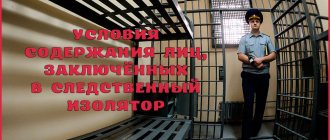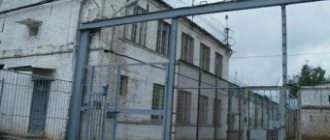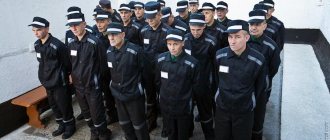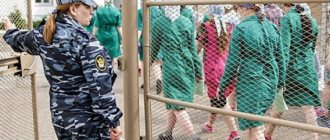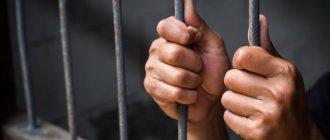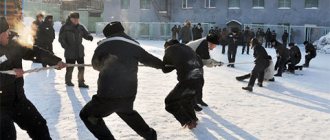How many prisons are there in Russia and what kind of regimes are there?
Currently, according to the Federal Penitentiary Service, there are 35 women’s correctional colonies in Russia. About 60,000 women and girls are serving their sentences in these institutions, which is 5% of the total number of prisoners in Russia. About thirteen thousand of them are minors (read more about how life is for inmates of female juvenile colonies here).
In a general regime colony, convicts serve time for serious criminal acts committed for the first time, as well as for crimes of minor and medium gravity, if the judicial authority considers that the correction of such persons is impossible in a settlement. A strict regime is applied only to repeat offenders and especially cruel murderers.
In addition to correctional colonies, there are institutions such as pre-trial detention centers, in which convicts are under investigation and awaiting further distribution. There are three women's pre-trial detention centers in Russia (Moscow, St. Petersburg, Yekaterinburg).
Read more about the main differences between a maximum security colony and a general colony and others here, and learn about how they live in a maximum security colony, what it is and why it’s better not to go there, in this material.
Description
The maximum security colony is divided into residential and industrial zones. The latter houses production facilities. The residential area, in turn, is divided into several “local zones”. They house dormitories for convicts. In the residential area, as a rule, there is also a dining room, a library, a club, an outpatient clinic, a bathhouse, and in some cases a small hospital designed for 10-30 people. In addition, there is a headquarters intended for administrative workers. There is often a church on the territory of the colony. It is usually built by the prisoners themselves. The maximum security women's colony also includes a school for convicts. In the residential area there are premises for long-term (from 1 to 3 days) and short-term (2-4 hours) meetings.
The most stringent correctional MLS
Moscow pre-trial detention center No. 6 is considered one of the most brutal prisons. The prisoners themselves call it nothing more than “SIZO 666”, since the conditions of detention can be called hellish.
Attention! More stringent conditions are observed in colonies where women who have committed repeated and serious crimes are sent, i.e. repeat offenders.
Lack of sleeping places, overcrowded cells and unsanitary conditions. Diseases such as tuberculosis and syphilis flourish as a result of the lack of medical care and basic living conditions. A completely healthy, and sometimes innocent, person emerges sick and exhausted a few months later. Activists and human rights defenders are sounding the alarm, however, to no avail.
Correctional colonies in Mordovia are often mentioned as places where it is better not to go. These institutions are classified as high security detention centers. Their conditions are much worse compared to other similar places of detention. The arbitrariness of the authorities, dirt and meager food are just a few of the things that those serving sentences on the territory of these institutions will have to face.
- IK-13 and IK-14, located in the village of Partsa.
- IK-2 in the village of Java.
"Snowflake"
From the Khabarovsk Territory, where a new prison for lifers is located, prisoners are heard complaining about the roar of fighter jets from Komsomolsk-on-Amur. But this is not their only problem, because it is impossible to escape from pre-trial detention center-4. People argue about which prison is the worst in Russia, and since 2014, the majority have named “Snezhinka”. In 2012, construction ended, and 2 years later the building was put into operation. Pre-trial detention center-4 frightens prisoners not only because of its “pleasant” neighborhood (pedophiles, maniacs, murderers, terrorists), but also because of its perfect security system.
The prison is equipped with motion sensors, CCTV cameras at every turn, and doors are opened using retinal scans of staff. The colony received its name due to the location of the buildings. Seven buildings stand in such a way that if you look at photographs taken from above, you can see a snowflake. It has space for 378 prisoners, who will be housed in 144 cells. The first criminals were brought in from the Black Golden Eagle in 2022, and this colony was closed.
The daily routine is the same as in “Black Dolphin”. In their free time from work, criminals read, play chess, and watch TV. They have access to the prison store where they can buy sweets. The limit for the first 10 years is 6 thousand rubles. This money needs to be earned. Among the prisoners: Stanislav Tishchenko - a bandit from the 90s, Alexander Lozhkin - a mass murderer in the Middle Urals, Maxim Kiselev - a thug from Novokuznetsk.
Pre-trial detention center for women - what is it?
A pre-trial detention center stands for a pre-trial detention center in which there are persons under investigation, namely, those people whose criminal case is under investigation or legal proceedings and who are awaiting further distribution to a correctional institution or colony.
All other institutions of this type in Russia are mixed, where both men and women serve their sentences. Unlike some men’s detention centers, where certain “concepts” may apply in everyday life, for women everything is simpler and relatively freer. The main attention is paid to everyday life and the distribution of responsibilities between cellmates.
Procedure for stay and transfer
Convicts who are admitted to general regime colonies, after the sentence comes into effect, are sent to normal conditions. Other prisoners can also be transferred to them. For example, those who were on lighter conditions in case they were recognized as persistent violators of discipline in the institution. At the same time, those who served their sentences in strict conditions can be transferred to normal conditions. This is possible if they have no violations or penalties, and they work conscientiously for a certain period. If the convicted person is characterized extremely negatively, often behaves inappropriately, and does not comply with established rules, he is transferred to strict conditions. In this case, the prisoner is placed in a locked cell. They have the right to an hour and a half walk every day if they are not working in the open air. Those who committed intentional crimes during their stay in the colony are transferred to strict conditions in a colony with a special regime of detention. And those who have been convicted of grave and especially grave acts are placed in them immediately after arrival. They are transferred to lighter conditions from normal conditions for exemplary behavior.
In this case, convicts receive the right to live in dormitories.
Correctional colonies: living conditions
Most cells are designed for 40-60 people, the beds are installed in two rows , the prisoners themselves call them “bunks”. The cell has a kitchen, where women cook themselves using products purchased from a local store or those sent by relatives, as well as a toilet and shower. Once a week – bath.
Reference. According to prisoners, one of the main inconveniences is the lack of privacy, since most intimate procedures are carried out in full view of their fellow inmates.
Cleaning in the barracks is carried out three times a day, the schedule is set by the senior. Missing duty is unacceptable and is punishable by additional cleaning days. The right to skip duty can be purchased for a pack of cigarettes, food or money.
According to the rules, each convicted person must be given a set of clothes and underwear for a period of one year. Often this rule is not followed. Half of the things are missing, or even issued less than once a year. Prisoners do not have the opportunity to dress warmly in the winter, which leads to an increase in the number of colds. Those who are unable to receive parcels from home have to exchange clothes from fellow inmates or wear cast-offs.
Schedule
A prisoner's standard schedule includes items such as:
- climb;
- toilet;
- Three meals a day;
- working hours with a lunch break;
- personal time from 30 minutes to 1 hour;
- continuous 8-hour sleep.
The day begins with getting up at 6 am, making beds, hygiene procedures and formation for roll call. The prisoners have breakfast and the working day begins, with a break for lunch, until 7-8 pm. After dinner - free time, which is spent at your own discretion: reading, letters home, handicrafts, etc.
Nutrition
The calorie content of the daily diet is approximately 2600–3000 kcal. Dairy, meat, vegetable dishes, as well as hot dishes are required. Prisoners purchase sugar, confectionery, fruits, and semi-finished products on their own, according to the permitted list.
Read more about food in prisons here.
Work and leisure
The working day is 12 hours or on a two-to-one schedule.
The main task is to meet production standards. Reference. Women carry out activities such as cutting and sewing, making workwear, working in a bakery, washing dishes, cleaning, cooking, and working in local art workshops and libraries.
In the absence of the necessary skills, convicts have the opportunity to obtain a profession or retraining in order to subsequently work in the acquired specialty. Training is carried out according to a separate schedule and is compiled individually.
Many correctional institutions have amateur clubs, libraries and study groups organized by the prisoners themselves. Women organize competitions, organize exhibitions, stage plays, hold holidays and even beauty contests.
Religion and Worship
According to the Penal Code of the Russian Federation, Article 14 “Ensuring freedom of conscience and freedom of religion of convicts,” prisoners have the right to profess any religion , as well as to conduct the necessary rituals both in the territory of detention and in specially designated territories, if any.
According to the convicts, faith and religion are what give them the strength to endure their sentences and with dignity endure all the hardships and difficulties associated with prison life. It helps to sincerely repent and enter a new life not as a broken person, but as a full-fledged person with new goals and hope for the future.
Prisons often build their own churches for prisoners to visit during their free time. The convicted person can confess or receive communion, and in case of serious illness the prison provides a priest.
Dates and visits
The types of visits with convicted persons, as well as their number, are determined by the Criminal Executive Code of the Russian Federation (Article 89) - a convicted person has the right to two types of visits within the framework of the rules of a particular correctional institution:
- short-term, which last 4 hours;
- up to three days with accommodation on the territory of the correctional institution;
- in a general regime penal colony it is permissible to have 6 short-term and 4 long-term visits;
- in a strict regime penal colony, 2 short-term and 2 long-term visits are allowed.
The head of the correctional institution independently determines the procedure and place of the meeting.
Read more about the nuances of long-term and short-term visits in maximum security colonies here.
Transfer of things and products
The transfer of things and products is carried out as usual, like all other institutions of this type. List of items allowed for transfer:
- socks, T-shirts and underwear;
- towel and bed linen;
- sports suit;
- sneakers, shower slippers, boots, galoshes;
- personal hygiene items: napkins, toilet paper, sanitary pads, combs, toothbrush;
- unbreakable dishes (plastic, aluminum);
- writing paper;
- a set of pens, with a blue and black core;
- personal photographs (no more than three);
- objects of religious worship (cross, icon, Bible, Koran);
- sweater;
- jacket.
Products:
- canned food and semi-finished products;
- instant noodles, crackers, chips;
- honey and condensed milk in soft packaging;
- confectionery: sweets, cookies, gingerbreads, chocolate (up to 2 kg);
- vegetables and fruits, except citrus fruits (oranges, lemons, grapefruit, pamelo);
- Tea coffee.
Motherhood
Perhaps one of the most difficult and painful topics regarding a woman’s stay in prison. Motherhood is the main purpose and meaning of every woman’s life, and the pregnancy period is one of the most difficult and responsible. Medical care in prison is often unable to provide the expectant mother with the necessary medications, and poor nutrition and hard work only worsen the situation.
Important! Doctors do not bother to examine expectant mothers, who may not be under medical supervision during the entire period, as a result of which a woman is not always able to carry a child to term, not to mention the fact that the baby is born healthy and full-fledged...
Most often, immediately after birth, the newborn is sent to the children's department of the hospital where he undergoes a medical examination, after which he is sent to a baby home.
Not every colony provides the opportunity for a mother to be with her child up to three years of age. Currently, there are 10 colonies with an orphanage in the Russian Federation. Children in such institutions are under the supervision of teachers and provided for at state expense until the age of three, after which they are sent to an orphanage or to the relatives of the prisoner. During the period of placement of a child, the mother is granted leave of 15 days excluding travel. In the future, annual leave for visiting the child is granted for the same period.
"Black Dolphin"
In the Orenburg region there is the Black Dolphin prison. It contains murderers, maniacs, rapists, cannibals, sentenced to life imprisonment. Documentary makers make films about them. 2-4 people are accommodated in a cell. If a prisoner has committed a brutal crime or does not get along with his cellmates, he is transferred to solitary confinement. Monitoring of convicts does not stop even for a minute. The light doesn't turn off. Security monitors them 24 hours a day via video surveillance, and every 15 minutes the guards check them in their cells.
Photo: TASS
Prisoners are raised at 6 am and go to bed at 10 pm. In the morning, criminals make their bed and are not allowed to sit or lie on it during the day. There are chairs in the room, you can sit there. If the convict is taken out of the cell, he is accompanied by a convoy of 3-4 people and a dog handler with a dog. The criminal does not move straight with his head held high, his hands are wringed and he is led in the letter “G” to the designated place. To transfer a prisoner from one building to another, he is blindfolded to prevent him from being oriented. The horror of prison is that not a single person managed to escape from there.
The Black Dolphin houses 800 criminals and 900 staff. Among the “regulars” there: Vladimir Nikolaev - the cannibal from Novocheboksarsk, Oleg Rylkov - “The Tolyatti Ripper”; Vladimir Mukhankin - Chikatilo fan and serial killer; Isa Zainudinov - terrorist who claimed 64 lives; Tamerlan Aliyev - extremist who killed 19 people; and others.
Release on parole
Conditional early release can be applied only after the convicted person has actually served:
- at least one third of the sentence imposed for a crime of minor or medium gravity;
- not less than half of the sentence imposed for a serious crime;
- at least two-thirds of the sentence imposed for a particularly serious crime.
How to get it and what does the court pay attention to?
- behavior of the convicted person in the colony, compliance with the regime and internal regulations;
- degree of repentance, admission of guilt and willingness to bear responsibility for the offense committed (compensation for moral and material damage to the victim);
- sincerity in repentance and willingness to change one’s life, learn a new profession, and be useful to society;
- whether the convicted person has received incentives or penalties from the prison administration;
- presence of an official place of work and attitude towards work in general;
- participation of the convicted person in the life of the team, work and leisure activities during the process of serving the term;
- availability of permanent residence or plans to acquire it;
- willingness to become a good citizen, benefit society and work.
Attention! It is worth noting that the court will evaluate the totality of the circumstances. Lack of place of residence or work, in the presence of other positive factors, will not become an obstacle to satisfying parole.
"Polar Owl"
A gloomy institution for especially cruel and dangerous prisoners is the Polar Owl prison, which is located above the Arctic Circle. Here, those who will never be released are serving life sentences - for example, the organizers of the Beslan terrorist attack. Conversations in full voice between prisoners are prohibited here, only in whispers. No leisure or sports activities - only work.
According to the authorities, not a single innocent convict ended up in the Polar Owl. Any manifestation of kind human feelings by prison staff towards inveterate criminals is severely punished.
Hierarchy in cells
Relations between prisoners are, as a rule, neutral. This is not a men's prison, where there is a struggle for leadership; the concept of “lowered” does not come up often. The exceptions are child killers - they, as a rule, are hated in women's prisons and can be humiliated or even beaten.
The hierarchy in the women's cell is like a beehive and, in fact, resembles a large family, with its own nuances, of course. There is a “womb” - the eldest, her assistants, to whom the eldest delegates her unspoken responsibilities, and the rest of the women.
The assistants monitor cleanliness, draw up a duty schedule, monitor food intake, and inspect the cell for items that are not allowed. Women's unions are often formed in prison, a so-called “family” in which they communicate, they can share food, clothing, cosmetics, but these relationships cannot be called bosom friendship, although the cases are different. Sometimes former cellmates remain friends even after release.
"Vologda nickel"
Another place where the most brutal criminals live until the end of their lives is the Vologda Pyatak. The prison is famous for its inhumane rules. Around the clock, zone employees monitor particularly violent criminals in shared cells. Only prisoners who have gone insane are kept separately, the number of which increases every year.
Prisoners are prohibited from raising their eyes during walks and when moving outside their cells; they are not allowed to lie down from 6 a.m. to 11 p.m.—only sit or stand. Most house sitters are required to work in sewing workshops for 12 hours a day. In this prison, the percentage of prisoners who have gone crazy and contracted tuberculosis is off the charts.


